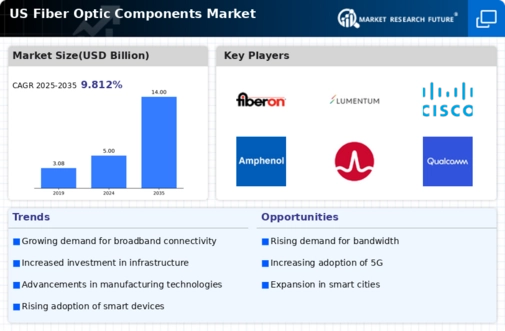Rising Cybersecurity Concerns
Rising cybersecurity concerns are influencing the fiber optic-components market in the US. As cyber threats become more sophisticated, organizations are increasingly prioritizing secure data transmission methods. Fiber optic technology is inherently more secure than traditional copper wiring, making it an attractive option for businesses looking to protect sensitive information. The fiber optic-components market is likely to experience growth as companies invest in fiber optic solutions to enhance their cybersecurity measures. According to recent studies, the cybersecurity market is projected to reach $300 billion by 2026, with a significant portion of this investment directed towards secure communication technologies. This trend underscores the importance of fiber optics in safeguarding data, thereby driving demand for related components.
Increased Adoption of Smart Technologies
The increased adoption of smart technologies across various sectors is significantly impacting the fiber optic-components market. Industries such as healthcare, manufacturing, and transportation are integrating smart solutions that rely on high-speed data transmission. The fiber optic-components market is likely to see a surge in demand as these technologies require reliable and fast connectivity. For instance, smart cities initiatives in the US are promoting the use of fiber optics to support various applications, including traffic management and public safety systems. This trend is expected to drive the market growth, as municipalities invest in fiber optic infrastructure to enhance operational efficiency. Furthermore, the integration of smart technologies in homes, such as smart meters and security systems, is also contributing to the demand for fiber optic components.
Growth in Data Centers and Cloud Services
The increasing reliance on data centers and cloud services is driving the fiber optic-components market in the US. As organizations migrate to cloud-based solutions, the need for robust and efficient data transmission becomes paramount. The fiber optic-components market is poised to benefit from this shift, as fiber optics provide the necessary bandwidth and speed for data transfer. According to industry reports, the US data center market is expected to grow at a CAGR of 5.5% through 2027, with fiber optic technology being a critical component in meeting the demands of high-capacity data handling. This growth is further fueled by the rise of big data analytics and the Internet of Things (IoT), which require reliable and fast connectivity. Consequently, the demand for fiber optic components is likely to surge as data centers expand and evolve.
Regulatory Support for Broadband Expansion
Regulatory support for broadband expansion in the US is a crucial driver for the fiber optic-components market. Government initiatives aimed at increasing internet access in underserved areas are leading to significant investments in fiber optic infrastructure. The fiber optic-components market is benefiting from these regulatory measures, as they encourage telecommunications companies to deploy fiber networks. Recent legislation has allocated billions of dollars to improve broadband access, particularly in rural regions. This funding is expected to create a substantial demand for fiber optic components, as companies seek to meet the requirements set forth by regulatory bodies. Additionally, the push for universal broadband access aligns with the growing recognition of internet connectivity as a vital utility, further solidifying the market's growth prospects.
Expansion of Telecommunications Infrastructure
The expansion of telecommunications infrastructure in the US is a primary driver for the fiber optic-components market. As the demand for high-speed internet continues to rise, telecommunications companies are investing heavily in upgrading their networks. This investment is projected to reach approximately $100 billion by 2026, focusing on fiber optic technology to enhance connectivity. The fiber optic-components market benefits significantly from this trend, as the deployment of fiber networks requires a variety of components, including cables, connectors, and transceivers. Moreover, the Federal Communications Commission (FCC) has initiated programs to promote broadband access, further stimulating the market. This infrastructure expansion not only supports residential users but also facilitates the growth of businesses, thereby increasing the overall demand for fiber optic components.





















Leave a Comment